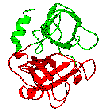
 |
3Dee - Database of Protein Domain Definitions |
Classification is most simply performed by taking the protein chain as the basic unit. However, it has long been recognised that classification should really be performed on structural domains rather than chains since a protein may contain more than one domain. For example, two proteins, each with two domains, may share only one domain in common. In addition, a protein domain may be composed of more than one chain.
Classification of domains is complex. Although structural domains are often thought of as compact, semi-independent units (Richardson, 1981), there is no binding definition of a domain. There are many proteins for which domains are difficult to define, or the domain definitions are ambiguous. In 3Dee, the program DOMAK (Siddiqui & Barton, 1995) was used initially to create the domain definitions which were then inspected and corrected where necessary. Care has been taken in the 3Dee database to ensure that domain definitions are consistent within sequence families.